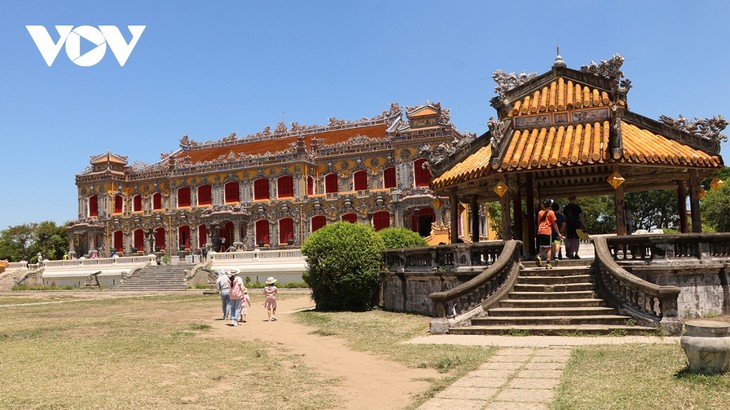 Kien Trung palace after restoration (photo: Vinh Thong-Le Hieu) Kien Trung palace after restoration (photo: Vinh Thong-Le Hieu) |
Among the most significant architectural works of the Nguyen Dynasty is the 200-year-old Thai Hoa Palace in Hue. This palace was the site of important national ceremonies and royal meetings, hosting the King, royal family members, and high-ranking mandarins. The project to preserve and restore the entire Thai Hoa Palace on an area of 7,100 m2 started in November 2022 with an investment of more than 5.1 million USD.
Before any restoration work commenced, experts and craftsmen meticulously documented every detail of the palace, taking photographs, creating imprints of decorative patterns, and marking the positions of wooden structures.
Components that had decayed beyond repair were rebuilt, while those with minor damage were carefully restored. The goal was to maintain the palace's originality and aesthetic by using specific materials like traditional bricks, tiles, and wood. Hundreds of skilled workers, including artisans like Le Van Nhuong from Duc Ly commune, played a crucial role in this endeavor.
Nhuong said: "The restoration must preserve the authenticity, quality, and soul of the relics. We applied traditional techniques in combination with modern methods approved by the Management Board to ensure the structure's durability. Thai Hoa Palace is a large project, requiring us to be extra meticulous. We discussed seriously about construction plans and workforce, combining technical drawings with our experience and traditional methods."
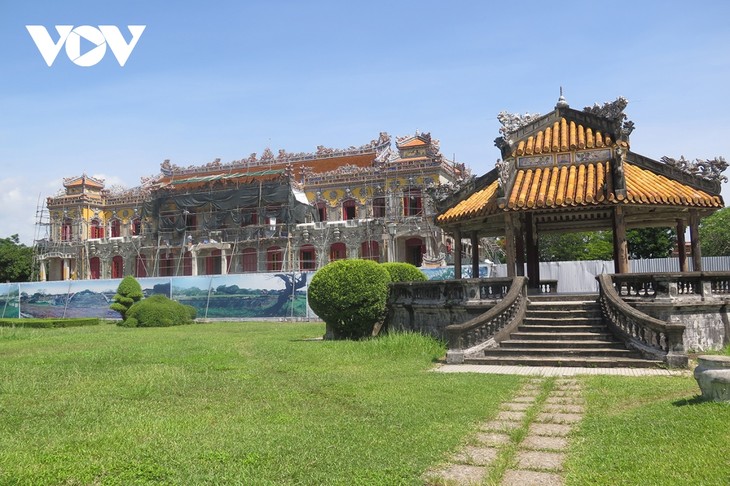 Kien Trung palace during restoration process (photo: Vinh Thong-Le Hieu) Kien Trung palace during restoration process (photo: Vinh Thong-Le Hieu) |
The restoration of Thai Hoa Palace is currently being evaluated to ensure the preservation of its original elements. Ho Huu Hanh, Director of Hue Monuments Restoration Company, said that from 1805 to 1945, the Thai Hoa Palace underwent 22 restorations. Each restoration added a new coat of paint, necessitating the careful removal of these layers to reveal the original color. Modern 3D technology was used to create a virtual reconstruction of the palace, providing a comparison basis during the restoration process.
Hanh elaborated: "This restoration project is particularly challenging due to the many important details, including poetry boxes recognized by UNESCO as documentary heritage. The throne and its precious canopy, which are national treasures, were also a concern. We explored numerous solutions to ensure these treasures remained unharmed during the restoration."
 Many construction in the Hue Monuments Complex have been restored. Many construction in the Hue Monuments Complex have been restored. |
Since its recognition by UNESCO as a World Cultural Heritage site in 1993, the Hue Monuments Complex has seen the restoration of around 170 structures, including the Ngo Mon Gate, Trieu Mieu, Hung Mieu, The Mieu, and the tombs of Kings Gia Long, Minh Mang, and Tu Duc. The Hue Monuments Conservation Center has collaborated with 21 international organizations and 9 Vietnamese agencies to study the relics' status quo and train personnel in heritage conservation.
Architect Phung Phu, former Director of the Hue Monuments Conservation Center, said the Nguyen dynasty left behind a unique wooden architecture system. “Some years ago, I recommended that afforestation plans include the cultivation of timber specifically for heritage preservation projects, as nearly all our relics are made of wood. This will ensure a steady supply for centuries to come."
The Hue Heritage Conservation Fund, managed by Thua Thien Hue province, is vital to these preservation efforts. The fund is financed by the state budget, donations from domestic and foreign organizations and individuals, and other legal sources of income.
Hoang Viet Trung, Director of the Hue Monuments Conservation Center, said: "Recently we raised nearly 9 billion VND from philanthropists and the community for conservation work. The fund has spent a lot on conserving tangible and intangible heritages in Hue city.”
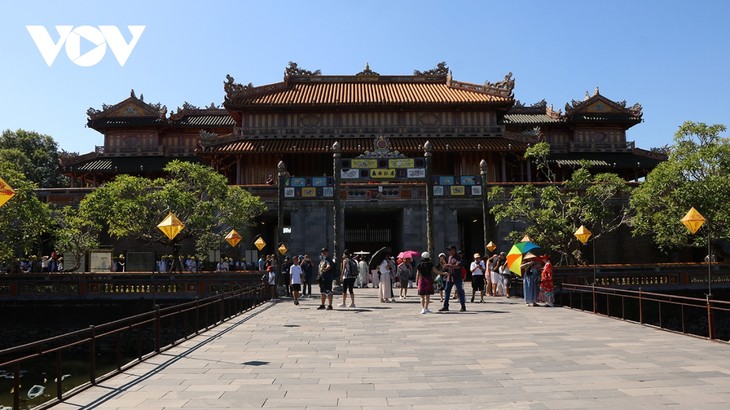 Hue Monuments Complex always attracts a large number of visitors. Hue Monuments Complex always attracts a large number of visitors. |
Despite advances in science and technology, preserving these sites presents challenges. Phan Thanh Hai, Director of the ThuaThien-Hue Provincial Department of Culture and Sports, said: "One of our biggest challenges is the lack of artisans. In the past, Hue was a hub for talented craftsmen from across the country. Now, it's difficult to train workers to reach the same level of skill as their predecessors."
Preserving and promoting heritage is seen as a vital resource for sustainable development. Nguyen Thanh Binh, Vice Chairman of the Thua Thien-Hue Provincial People's Committee, said the Politburo’s resolution on developing Thua Thien-Hue by 2030, with a vision to 2045, aims to elevate the province to a centrally-run city, built on the preservation and promotion of the ancient capital's heritage and identity, characterized by culture, ecology, and smart, environment-friendly elements.
The Hue Monuments Conservation Center has set up 21 tourist service venues, from the Imperial City to the tombs of Minh Mang, Tu Duc, and Khai Dinh, and organized various performances to bring Hue’s heritage closer to both tourists and the local community.
"Visiting Hue, we learn more about the city's tangible and intangible cultural values. The landscapes and the ancient capital are amazingly beautiful and unique. The royal music performances and Hue’s cuisine transport you back to the Nguyen Dynasty era hundreds of years ago."
"When visiting the Hue Imperial City, we felt like we were stepping into an ancient world. Many buildings have been restored and embellished. The old and new architectures blend together. It’s difficult to see the difference among the restored components as at some other places."
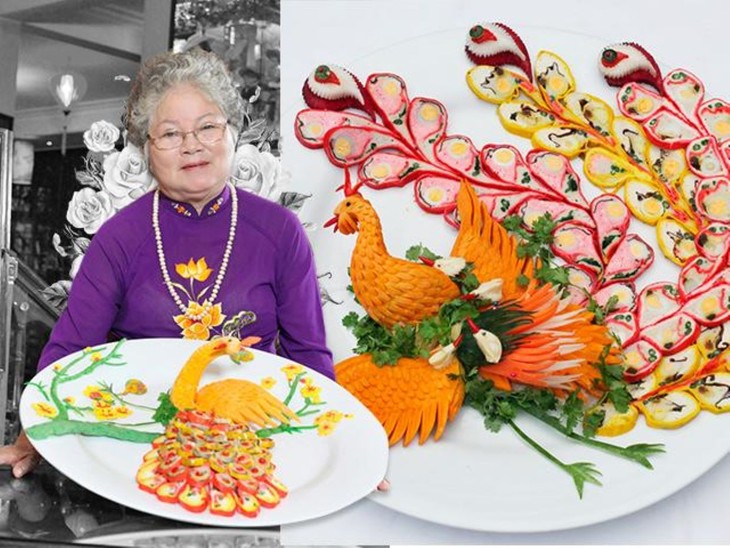 Hue's cuisine is an art. (photo: VOV) Hue's cuisine is an art. (photo: VOV) |
Hue city is renowned for its rich culinary culture, boasting 1,700 of Vietnam's 3,000 documented dishes from the Nguyen Dynasty's Code of Conduct. The cuisine is divided into three main categories: royal, folk, and vegetarian. On July 10, the People's Committee of Hue City announced a plan to nominate "Hue – Creative City," with a focus on its cuisine, to join UNESCO’s Creative Cities Network.
The variety of ingredients, the transformation of popular dishes into royal delicacies, and the skills of artisans, chefs, and culinary professionals have all contributed to Hue’s culinary fame.
Hoang Trong Nghia, a visitor from Bac Giang province, said: "I'm very impressed with Hue's traditional cuisine. The dishes are diverse and eye-catching. I’m very happy with this experience."
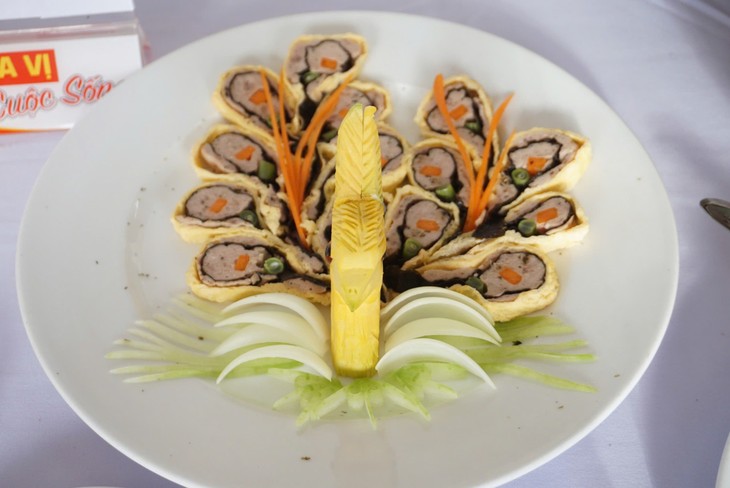 "Hue – Creative City" focuses on its cuisine. (photo: VOV) "Hue – Creative City" focuses on its cuisine. (photo: VOV) |
Hue’s cuisine is not only about taste but also about presentation, with a focus on quality over quantity. The city's culinary heritage, recorded in historical documents, includes a vast menu of luxurious dishes and the royal etiquettes and rituals surrounding meals.
Culinary artisan Phan Ton Tinh Hai said: "It’s my great desire to spread Hue’s cuisine across the country and beyond our boundary. I wish to introduce Hue’s cooking ingredients, nutritional and aesthetic values as well as traditions to the wider public."
Nguyen Thanh Binh, Vice Chairman of the ThuaThien-Hue Provincial People's Committee, said over the past years, the province has promoted the brand "Hue – Culinary Capital" through various cultural and tourism initiatives.
“Hue city and the provincial Department of Culture, Sports, and Tourism have been tasked with developing the 'Hue – Creative City' dossier to present to UNESCO by the end of 2025. Along with titles like ASEAN Cultural City and Green Tourism City, Hue aims to join UNESCO’s Creative Cities Network," Binh said.
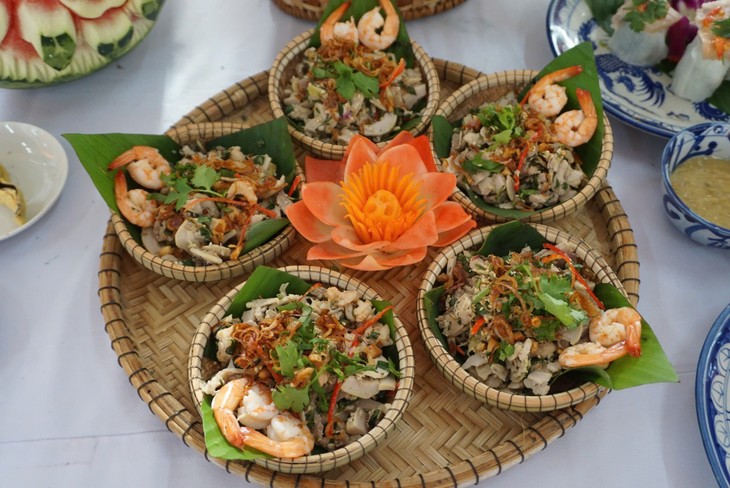 Hue's cuisine is divided into three main categories: royal, folk, and vegetarian. (photo: VOV) Hue's cuisine is divided into three main categories: royal, folk, and vegetarian. (photo: VOV) |